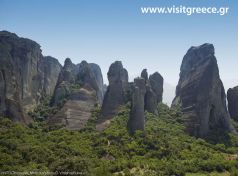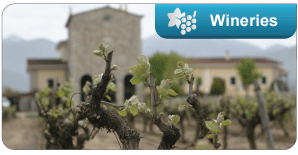Wine tourism in Thessalia
Thessalia is in the northern part of Central Greece. At its centre, the Plain of Thessalia is the largest unified lowland area of Greece and is surrounded by mountains on which the largest vineyards are located. The main characteristic of the Thessalia vineyards is that they are located in or very near beautiful natural landscapes and tourist destinations, making wine tourism in Thessalia particularly attractive.
The Protected Geographic Indication (PGI) Meteora wines are produced in the northwestern part of Thessalia, in the grape-growing region that is south of the Meteora-Kalambaka area and in the centre of which the Theopetra Cave is located. The rocks of Meteora are a geological monument of global importance and the six monasteries there are a religious centre for all of Greece. As such, it is a particularly popular destination for Greek and foreign travellers who are well accommodated by the developed tourism infrastructure of Kalambaka, which thus serves as a hub for wine tourism in Thessalia. Other fascinating elements of the area include its proximity to southern Mt. Pindos to the west and the areas of Aspropotamos and Koziakas, which feature important monuments such as the Monastery of Timiou Stavrou and the Porta Panagias Church.
Further south, after the cities of Trikala, with Asklipio and Pelineon, and Karditsa, with the archaeological museum, is Plastiras Lake. It is one of the oldest artificial lakes in Greece and is so integrated into the natural environment that it has created a magnificent landscape that attracts many visitors. At the same time, high-quality tourism infrastructure has also been developed there. The Mesenikolas Vineyard that produces the PDO Mesenikola wines is located in a beautiful setting on the eastern shore of the lake. The monasteries of Korona, Petra and Spilia are located around the lake and together with those in Meteora complement wine tourism in Thessalia with opportunities for religious tourism. The fortresses of Kallithiro and Fanari are a short distance away.
East of Meteora and north of the city of Larissa, with the ancient theatre and the archaeological museum, is the grape-growing region of Tyrnavos, which is located in the southern foothills of the highest Greek mountain, Mt. Olympus, and produces PGI Tyrnavos wines. A little further north, vineyards have grown up in the Elassonas area and there is marked development of tourism infrastructure under way, holding great promise for wine tourism in Thessalia. Perrhaebian Tripoli and ancient Krannonas stand out among the monuments of the greater region. On the other side of Mt. Olympus, on the northeastern edge of Thessalia, the Rapsani vineyard, which produces PDO Rapsani wines, is a special case. As most Greeks believe that whatever lies north of Tempi is considered Northern Greece, Rapsani has already developed connections with and has been inducted into the "Wine Roads of Northern Greece" network. Of particular interest to visitors is Mt. Kissavos, on the eastern side of Larissa.
The amazingly beautiful Mt. Pelio, located on the eastern side of the Pagasitikos Gulf in the Magnesia area (southeastern section of Thessalia) is one of the most fascinating Greek destinations for every season with an exceptionally well developed tourism infrastructure. The little Pelio train and the ski centre add to the magic of the mountain and of the beaches in the area. The Anchialos vineyard stretches out on the west side of the Pagasitikos Gulf just opposite, where wine tourism in Thessalia ends. This is where the PDO Anchialos white wines are produced. Some of the important archaeological sites in the area include Dimini, Sesklo, Alos, Feres and Dimitriada. Also of interest are the Athanassakio Archaeological Museum in Volos and the museum in Almyros.




